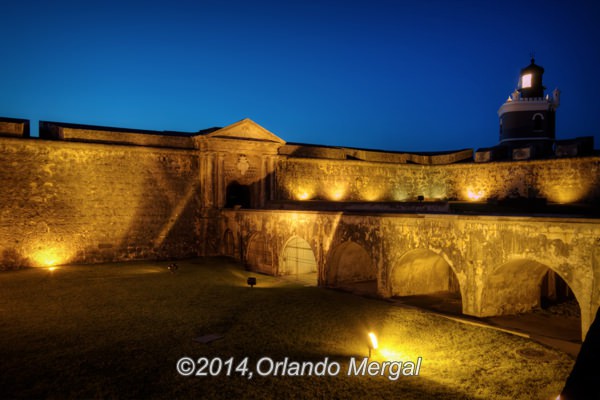
My wife and I waited for over an hour for me to take this shot. I think it was well worth the wait.
Last Monday was a sunny day. There wasn’t a cloud in the sky, which is rare for the month of August in Puerto Rico. Typically the summer months in Puerto Rico are characterized by overcast skies, usually not due to rain clouds but to the Sahara dust that covers the Island for weeks at a time.
Consequently, when I’ve been asked what’s the best time of the year to visit Puerto Rico I’ve always said “February” (see my post titled: “When To Visit Puerto Rico And Why?”).
But last Monday was perfect, so I packed up my camera, a wide angle lens, a tripod and a cable release and I headed for Old San Juan with my wife.
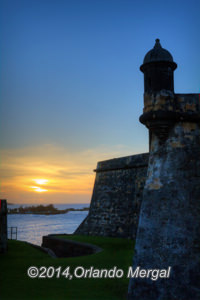
Here’s one of those glorious sunsets that you can only catch at El Morro. Click on the image to see it larger.
Photography can be a lonely sport. Sometimes you have to wait hours for that perfect shot to appear. And in the mean time, what do you do? Well, you converse. Thankfully my wife has been the perfect partner for over 30 years. We find the ideal spots, set up our equipment and have all sorts of conversations while we wait for that unique and fleeting moment to reveal itself. Then I press the shutter.
Nighttime photography is tricky stuff. Besides understanding the rudiments of composition you really need to have a grasp of exposure and how it works. As much as cameras have evolved during the last 20 or 30 years, they still can’t think. So you have to think for them.
Placing your camera on a tripod, setting it to “P” (which doesn’t stand for “professional”) and pressing the shutter button won’t yield images like the ones in this post. Those take a little more knowledge. Especially about exposure.

This image made the cover for the US National Park Service’s brochure for Fort San Cristóbal and Fort San Felipe del Morro. Click on the image to see it larger.
When a camera evaluates a scene it compares it to something called an 18% gray. Have you ever asked yourself which color is more prevalent when you step outside during the day? If your answer was “green” you are absolutely right. Well, in a photograph there are two types of information. There is luminance (the amount of brightness in the image) and there is chrominance (the amount of color information). Together they make up your image.
Well, this isn’t intended to be a technical article, so lets just say that 18% gray is what you have in the typical hue of green that you see all around you in nature.
So why did I go into all this technical jargon in a post about Old San Juan After Dusk? Well, because if you don’t consider these facts when taking nighttime shots all your bright areas will be blown out!
So what’s the trick? Bracketing! Professional photographers always bracket their shots. That means taking the picture at the exposure suggested by your camera meter and then taking a couple of underexposed or overexposed shots as the circumstances might require.
Another indispensable tool is a tripod. Why? Because there’s simply no way that you’ll hold the camera rock steady for the amount of time required to make a nighttime image. Especially if you take advantage of your lens’s sweet spot.
What’s that?
Most lenses give you the sharpest shots near the midpoint of their exposure scale. That means that if your lens goes from f/4.5 to f/29 (like my Sigma 10–20mm does), then your midpoint will be somewhere around f/11 or f/16. And what does “f” mean? Well, let’s just say that it’s your aperture value. Simply put, most lenses will give you the sharpest image when they are halfway open.
Why is that important?
Because the more you close down your aperture the longer your exposure is going to have to be. Hence, you will inevitably need a tripod and a cable release.
Why a cable release?
A cable release is a gadget that actuates your shutter without you needing to press the actual shutter button. Why is this important? Because at long exposures even the smallest vibration can ruin your shot.
Well, enough about the technical stuff. If you’re a photographer you should already know all these things. And if you’re not, at least I’ve pointed you in the right direction.
Old San Juan isn’t lit at night like many capitals in Europe or the United States are. Only some historical buildings and monuments are blessed with nighttime lighting. But that doesn’t mean that you can’t take spectacular night shots. “Au contraire”. San Juan offers a plethora of opportunities for the nighttime photographer, from stunning sunsets to striking silhouettes. All you need is a little imagination.
Of course, like a friend of mine always says, local photographers will always have an advantage because they’re always here. But with a little luck you’ll be at the right place at the right time to take that once-in-a-lifetime image that you can show with pride.
Take for instance this image that I made of “La Rogativa” (Procession Square) back in 2009. I made this image using a Canon EOS 50D body , a kit lens Canon EF 28–135mm a Manfrotto Tripod and a Canon Cable Release. It was shot at f/6.7, at 1/8 sec at a focal length of 47mm.
Chances are that no one in the world has —or ever will have— an image like this one because the fiery sky behind it was one of a kind. But that doesn’t mean that you can’t set up your camera and tripod at a similar position and take your own rendition. Like I said, part of it is knowledge and part is just showing up at the right moment.
Here’s another example. I took this shot on a cloudy day. Normally, cloudy days are useless days for landscape photographers. They’re great for shooting faces and flowers, but landscapes? Ugh!!! Well, here’s the exception.
I made this shot with the same equipment. My wife and I were about to leave Old San Juan. It was one of those days that started out pretty and deteriorated into an ugly cloudy evening. We were tired of walking so we sat for a couple of minutes near the south side of La Fortaleza (the governor’s mansion). All of a sudden the sky lit up in shades of yellow and fiery red. This is the kind of thing that you can’t plan for. It just happens!
There are also times when you have to construct your own image. Here’s an example. Take a look at the image on your right. It’s a physical impossibility. Most people look at it, love it and never give it another thought. But there are two things going on in this picture that simply can’t coexist.
I shot this image with my Canon 7D at an aperture of f/16 and a shutter speed of 16 seconds. That’s what accounts for the foamy water. Then why is the bird razor sharp? Simple! Becasue I put it there in Photoshop. If there’s one thing I have learned is that in this era of digital photography anything is possible even if it seems impossible.
Then there are the shots that you never expected to take, like the image of the “Totem Telúrico” that sits on the southern side of Quinscentennial Square on the north side of Old San Juan. I was just walking by during the “San Sebastian Street Fiestas” back in January of 2005. It was a cloudy night. And that’s exactly what caught my eye: the gloomy sky behind the “Totem Telúrico”.
I wasn’t carrying a tripod. So what did I do? I improvised. I placed my camera against a wall, held my breath and popped off a couple of shots at an aperture of f/2.8, 1/10 sec shutter speed and at a focal length of 24mm. I think it came out pretty good!
Finally, I want to mention my image of the “Raíces” fountain, that sits at the end of “La Princesa Promenade”. Now, here’s an image that you can only make if you bring the right equipment. Why? Because there’s nowhere to “lean your camera” or resort to any other “photographer’s trick”. If you don’t bring a tripod you won’t be able to make it.
I made this image back in 2004 using the now historic Canon EOS 20D. It was shot at an aperture of f/11 with a shutter speed of 1 second. The focal length was 42mm. The long exposure time is what accounts for the almost surreal aspect of the water.
As we’ve seen, nighttime photography is a lot of fun and you don’t need to live in Madrid or New York where most of the monuments and historical buildings are lit at night. Sometimes a sunset, a fiery sky or even a gloomy sky will do just fine towards making that one-in-a-lifetime shot. It’s all a matter of imagination, patience and perseverance.
Enjoy Puerto Rico,
©2014,Orlando Mergal, MA
____________________
Bilingual Content Creator, Blogger, Podcaster,
Author, Photographer and New Media Expert
Tel. 787–750-0000, Mobile 787–306-1590
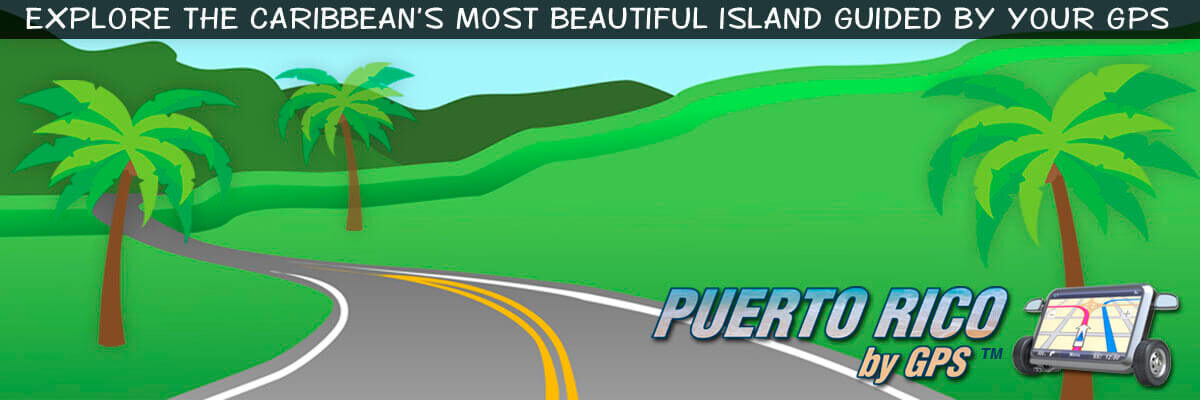
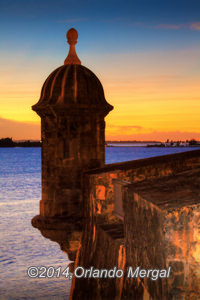
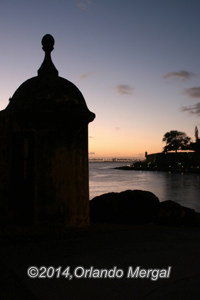

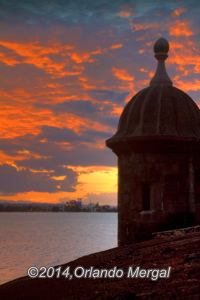

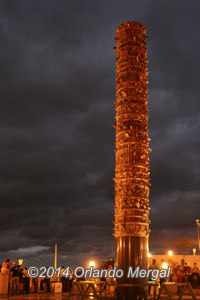
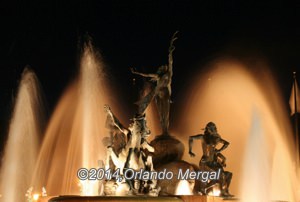

Excellent article Orlando!!! Keep up the good work!
Your Friend,
Edmundo
Testing! Thought I would try again and see if I could get it to work this time. I do love your post and am eager to get to San Juan to see how I do with my own attempts at night photography.
Hey Orlando, I like it but I have a question. Who is your audience? Other photographers won’t buy your work. I’m thinking that content about a walking tour at night with directions to all these places would have been much stronger for the general population than the technical stuff. However I did like it and I liked the images a lot. Keep up the good work and I hope to see you in Feb. john h
My audience are the tourists visiting Puerto Rico. However, many of those tourists bring their cameras and it would be a shame if they didn’t go home with some pretty pictures. Yes, maybe I did get a little to technical. I like the idea about the evening tour.